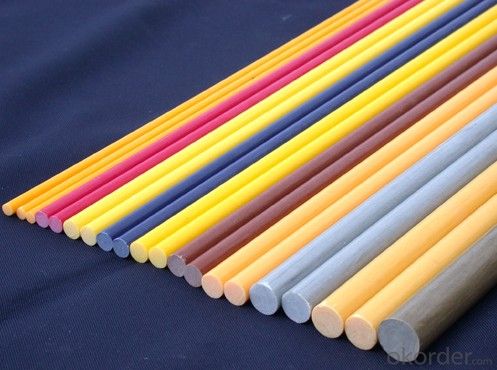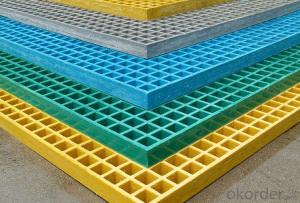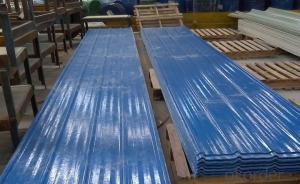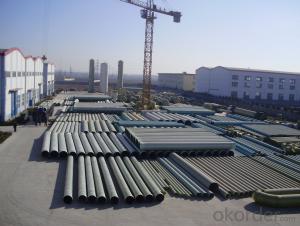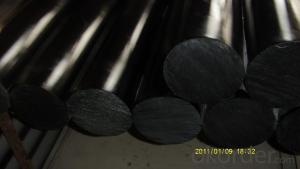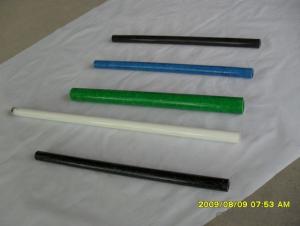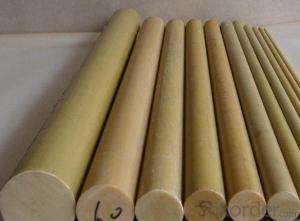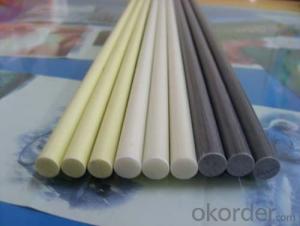FRP Rod Fiberglass Solid Pole
- Loading Port:
- China Main Port
- Payment Terms:
- TT OR LC
- Min Order Qty:
- -
- Supply Capability:
- -
OKorder Service Pledge
OKorder Financial Service
You Might Also Like
Specifications of FRP Rod Fiberglass Solid Pole:
1. high quality with low price
2. customized
The following size of FRP Rod Fiberglass Solid Pole are just regular size, we could do any size as customer's request):
Diameter (mm) | Weight(g) |
Ø2.0 | 6.0 |
Ø3.0 | 13.4 |
Ø4.0 | 23.9 |
Ø5.0 | 37.3 |
Ø6.0 | 53.7 |
Ø6.9 | 71.0 |
Ø7.9 | 93.1 |
Ø8.5 | 107.8 |
Ø9.5 | 134.6 |
Ø11 | 180.5 |
Ø12.7 | 240.6 |
Performance of FRP Rod Fiberglass Solid Pole:
|
|
Applications of FRP Rod Fiberglass Solid Pole:
It is suitable for Tent , kites, toys, model, planes, tool handle, golfbags, golftraining
nets, other sports apparatuses play a supporting role.
- Q: Can FRP pultrusion profiles be used in the construction of stadium seating?
- Yes, FRP pultrusion profiles can be used in the construction of stadium seating. FRP (Fiber Reinforced Polymer) pultrusion profiles offer high strength, durability, and corrosion resistance, making them a suitable choice for stadium seating applications. These profiles can be customized to meet specific design requirements and provide a lightweight alternative to traditional materials like steel or concrete.
- Q: How do FRP pultrusion profiles handle cyclic loading?
- FRP pultrusion profiles are known for their excellent resistance to cyclic loading. The combination of the fiber reinforcement and the resin matrix in the pultrusion process results in a highly durable and fatigue-resistant material. The inherent strength and stiffness of the fibers help to distribute the applied loads evenly, while the resin matrix absorbs and dissipates the energy from cyclic loading, preventing crack propagation and failure. This makes FRP pultrusion profiles a reliable choice for applications that involve repeated or fluctuating loads.
- Q: Can FRP pultrusion profiles be used in the construction of pedestrian bridges?
- Yes, FRP (Fiber Reinforced Polymer) pultrusion profiles can be used in the construction of pedestrian bridges. FRP pultrusion profiles offer several advantages that make them suitable for bridge construction. Firstly, FRP pultrusion profiles are lightweight yet extremely strong and durable. This makes them ideal for use in pedestrian bridges where weight considerations are important. The lightweight nature of FRP profiles also makes transportation and installation easier and more cost-effective. Secondly, FRP pultrusion profiles are corrosion-resistant, which is a crucial factor in bridge construction. Unlike traditional materials like steel or concrete, FRP does not rust or corrode, even in harsh environmental conditions. This property significantly extends the lifespan of the pedestrian bridge and reduces maintenance costs. Additionally, FRP pultrusion profiles offer design flexibility. They can be easily customized to meet specific project requirements, allowing for unique and innovative bridge designs. The material can be molded into various shapes and sizes, enabling the construction of aesthetically pleasing pedestrian bridges. Furthermore, FRP pultrusion profiles have excellent mechanical properties, including high strength-to-weight ratio and fatigue resistance. This ensures that the bridge can withstand the loads and stresses imposed by pedestrian traffic over an extended period. Lastly, FRP pultrusion profiles are non-conductive, making them a safe choice for pedestrian bridges. They do not conduct electricity, which reduces the risk of electrical accidents in areas where overhead power lines or electrical equipment are present. In conclusion, FRP pultrusion profiles are a suitable choice for the construction of pedestrian bridges due to their lightweight, corrosion-resistant, customizable, and mechanically strong properties. Their use can result in durable, low-maintenance, and visually appealing bridges that provide a safe and efficient means of pedestrian transportation.
- Q: What are the load-bearing capabilities of FRP pultrusion profiles?
- FRP (Fiber Reinforced Polymer) pultrusion profiles have excellent load-bearing capabilities. The load-bearing capacity of FRP pultrusion profiles is determined by several factors such as the type and arrangement of fibers, resin properties, and the overall design of the profile. FRP pultrusion profiles are commonly used in various industries due to their high strength-to-weight ratio. The reinforcing fibers, typically made of materials such as fiberglass or carbon fiber, provide the profile with exceptional tensile and flexural strength. These fibers are embedded in a resin matrix, which further enhances the load-bearing capabilities of the profile. The load-bearing capacity of FRP pultrusion profiles can be tailored to meet specific requirements by adjusting the fiber type, orientation, and resin properties during the manufacturing process. This allows for a wide range of design possibilities and enables engineers to optimize the profiles for different applications. Furthermore, FRP pultrusion profiles exhibit excellent resistance to corrosion, making them suitable for use in harsh environments. Unlike traditional materials such as steel or wood, FRP profiles do not rust or rot, ensuring long-term durability and structural integrity. Overall, the load-bearing capabilities of FRP pultrusion profiles are highly impressive, making them a reliable choice for various load-bearing applications such as structural supports, bridges, platforms, and industrial equipment.
- Q: Are FRP pultrusion profiles resistant to chemicals used in agricultural applications?
- FRP pultrusion profiles are known for their exceptional resistance to chemicals commonly found in agricultural settings. These profiles are composed of reinforced fibers and a polymer resin matrix, typically polyester or vinyl ester, which provide outstanding protection against a wide range of agricultural chemicals, including fertilizers, pesticides, herbicides, and acids. The inherent corrosion resistance of FRP pultrusion profiles makes them highly sought-after in agricultural applications where exposure to chemicals is prevalent. Unlike traditional materials like wood, steel, or concrete, these profiles do not deteriorate or degrade when exposed to aggressive chemicals. This resistance ensures that the profiles remain structurally sound and perform effectively throughout their long lifespan, even in harsh agricultural conditions. Additionally, FRP pultrusion profiles excel in their resistance to corrosion, moisture, UV radiation, and temperature fluctuations. This durability makes them ideal for a variety of agricultural applications, such as structural supports, fencing, grating, decking, and irrigation systems. However, it is important to note that while FRP pultrusion profiles are highly resistant to chemicals, they may still experience some level of degradation or staining when exposed to extremely concentrated or highly aggressive chemicals. To ensure compatibility with the chosen FRP pultrusion profiles, it is recommended to consult with the manufacturer or supplier regarding the specific chemicals used in the agricultural application.
- Q: Are FRP pultrusion profiles resistant to wear or abrasion?
- Yes, FRP (Fiber Reinforced Plastic) pultrusion profiles are highly resistant to wear and abrasion. The combination of the reinforcing fibers, typically glass or carbon, and the plastic resin matrix creates a material that is incredibly durable and can withstand heavy usage. The pultrusion process also ensures a homogeneous structure with fibers evenly distributed throughout the profile, further enhancing its resistance to wear and abrasion. Additionally, FRP pultrusion profiles can be engineered with specific additives or surface treatments to further enhance their resistance to wear and abrasion, making them suitable for a wide range of applications in various industries, such as construction, transportation, and marine.
- Q: How do FRP pultrusion profiles handle compression loads?
- The unique and effective handling of compression loads by FRP pultrusion profiles is attributed to their structure and material composition. By pulling continuous fibers, such as glass or carbon, through a resin bath and a heated die, the profiles are formed and cured. In terms of compression loads, FRP pultrusion profiles demonstrate exceptional performance. The incorporation of continuous fibers within the resin matrix results in highly rigid and strong profiles, enabling them to effectively withstand compressive forces. The fibers evenly distribute the load along the profile's length, preventing localized failure and ensuring overall structural integrity. Furthermore, the fiber reinforcement in FRP pultrusion profiles provides excellent resistance against buckling. Buckling occurs when excessive compressive loads cause instability and failure in slender structural members. The robust strength-to-weight ratio of the fibers helps prevent buckling, allowing the profiles to endure significant compression forces without compromising their structural integrity. Moreover, the resin matrix in FRP pultrusion profiles plays a vital role in handling compression loads. It acts as a protective layer, safeguarding the fibers from damage or fractures caused by compressive forces. Additionally, the resin serves as a medium for load transfer, effectively distributing the compressive load to the fibers, which then carry it throughout the entire profile. In summary, FRP pultrusion profiles are exceptionally well-suited for managing compression loads due to their fiber reinforcement and resin matrix. They offer remarkable strength, stiffness, and resistance to buckling, making them an ideal choice for various applications where compression loads are a concern.
- Q: Are FRP pultrusion profiles suitable for the manufacturing of boat hulls?
- Boat hulls can be effectively manufactured using FRP pultrusion profiles. These profiles possess numerous advantages that render them perfect for constructing boat hulls. Firstly, FRP pultrusion profiles are not only lightweight but also exceptionally sturdy and durable. Consequently, they are well-suited for boat hulls as their lightweight nature enhances fuel efficiency and enables increased speed. Moreover, their impressive strength-to-weight ratio guarantees that the boat can endure the rigors of the water without compromising its structural integrity. Secondly, FRP pultrusion profiles exhibit exceptional resistance to corrosion. This characteristic is of utmost importance for boat hulls, which are constantly exposed to water, salt, and other corrosive agents. The corrosion resistance of FRP pultrusion profiles ensures that the boat hull remains intact and maintains its performance over time, thus minimizing the need for frequent maintenance and repairs. Furthermore, FRP pultrusion profiles offer great design flexibility. They can be effortlessly molded into diverse shapes and sizes, thereby facilitating customization and optimization of boat hull designs. This flexibility empowers boat manufacturers to create hulls that are both functional and visually appealing. In addition to their strength, durability, corrosion resistance, and design flexibility, FRP pultrusion profiles also possess excellent electrical and thermal insulation properties. These properties are particularly important for boat hulls as they effectively prevent the passage of electrical currents and heat through the hull, thereby ensuring the safety and comfort of passengers and crew. Overall, FRP pultrusion profiles present an outstanding solution for boat hull manufacturing. Their lightweight, robust, and corrosion-resistant attributes, in conjunction with their design flexibility and insulation capabilities, make them an ideal choice for boat manufacturers seeking to produce high-performance and long-lasting vessels.
- Q: How do FRP pultrusion profiles perform in high-traffic areas?
- Due to their outstanding performance characteristics, FRP pultrusion profiles are a top-notch selection for high-traffic areas. Crafted from reinforced fiberglass and resin, these profiles create an incredibly sturdy material that can endure heavy loads and continuous foot traffic. The high strength-to-weight ratio of FRP pultrusion profiles is one of their key advantages. This unique feature enables them to be lightweight while remaining remarkably strong, allowing them to bear heavy loads without compromising their structural integrity. Moreover, their non-corrosive nature makes them perfect for areas with high foot traffic, where exposure to moisture, chemicals, and other corrosive elements is prevalent. Not only do FRP pultrusion profiles possess exceptional resistance to wear and abrasion, but they also maintain their original appearance and functionality for an extended period, even in high-traffic areas where conventional materials quickly deteriorate due to constant footfalls and movement. Furthermore, these profiles exhibit remarkable resistance to UV radiation, ensuring that they do not degrade or fade when exposed to sunlight. This is especially crucial for high-traffic areas situated outdoors or with substantial windows, as the profiles will retain their strength and aesthetics even with constant exposure to the sun. Regarding maintenance, FRP pultrusion profiles require minimal upkeep. Their color and finish are inherent in the material itself, eliminating the need for regular painting or sealing. This significantly reduces maintenance costs and efforts, making them a cost-effective choice for high-traffic areas. In conclusion, FRP pultrusion profiles offer exceptional strength, durability, resistance to wear and abrasion, non-corrosive properties, UV resistance, and low maintenance requirements. Their ability to withstand heavy loads and continuous foot traffic guarantees long-lasting performance, making them a dependable choice for any high-traffic environment.
- Q: Can FRP pultrusion profiles be used in the construction of offshore platforms?
- Yes, FRP (Fiber Reinforced Polymer) pultrusion profiles can be used in the construction of offshore platforms. FRP pultrusion profiles have several advantageous properties that make them suitable for offshore applications. Firstly, FRP pultrusion profiles are lightweight yet strong, which is crucial for offshore platforms that need to withstand harsh environmental conditions such as strong winds, waves, and corrosive saltwater. The high strength-to-weight ratio of FRP makes it an ideal choice for reducing overall weight while maintaining structural integrity. Secondly, FRP is highly resistant to corrosion, unlike traditional construction materials such as steel. This is particularly important in the offshore environment, where saltwater exposure can lead to rapid corrosion of metal structures. FRP pultrusion profiles do not rust or corrode, resulting in longer service life and reduced maintenance costs. Furthermore, FRP pultrusion profiles can be designed and manufactured to have excellent fire resistance properties. This is crucial for offshore platforms, as fire incidents can have catastrophic consequences. FRP materials can be engineered to meet specific fire safety standards, providing an added layer of protection. Additionally, FRP pultrusion profiles offer design flexibility, as they can be easily customized to meet specific project requirements. This allows for the creation of complex shapes and sizes, enabling efficient construction and installation of offshore platforms. Overall, the lightweight, corrosion-resistant, fire-resistant, and customizable nature of FRP pultrusion profiles make them a suitable choice for the construction of offshore platforms. They offer numerous advantages over traditional materials, contributing to improved safety, durability, and cost-effectiveness in offshore construction projects.
Send your message to us
FRP Rod Fiberglass Solid Pole
- Loading Port:
- China Main Port
- Payment Terms:
- TT OR LC
- Min Order Qty:
- -
- Supply Capability:
- -
OKorder Service Pledge
OKorder Financial Service
Similar products
Hot products
Hot Searches
Related keywords




